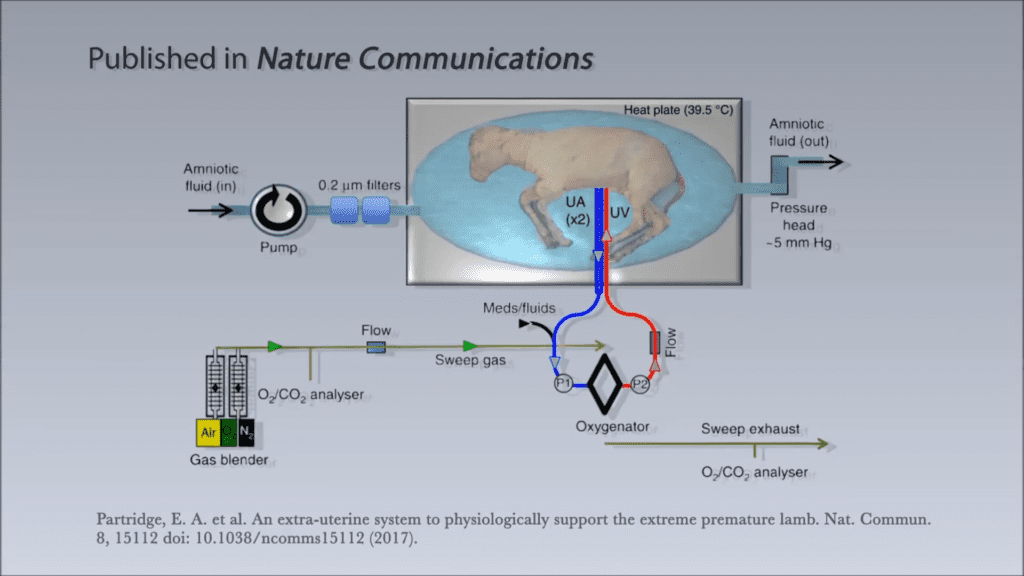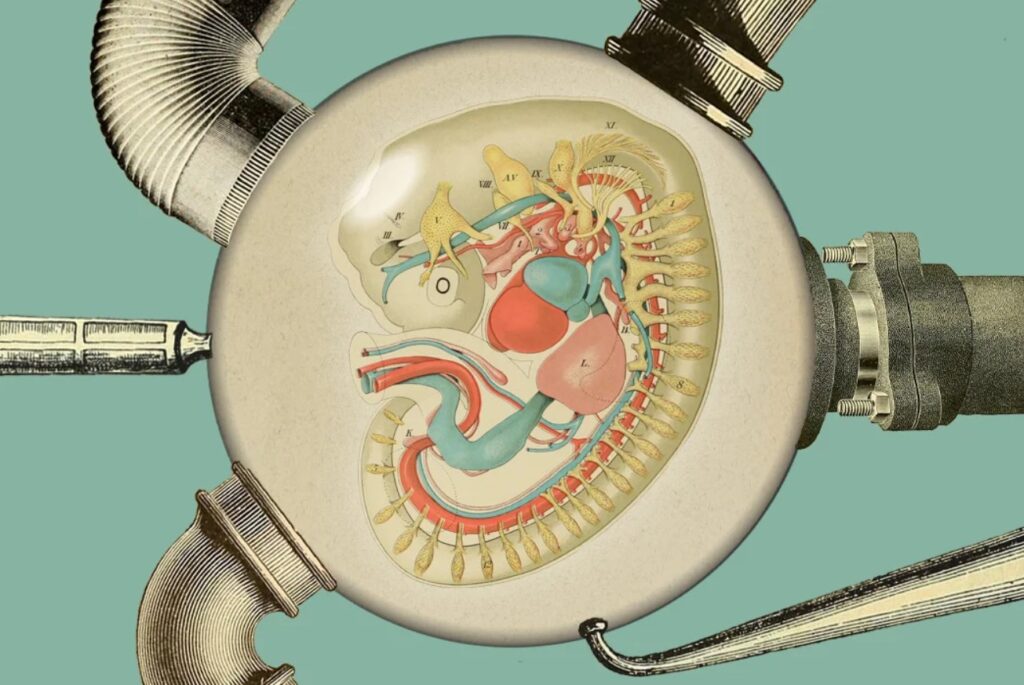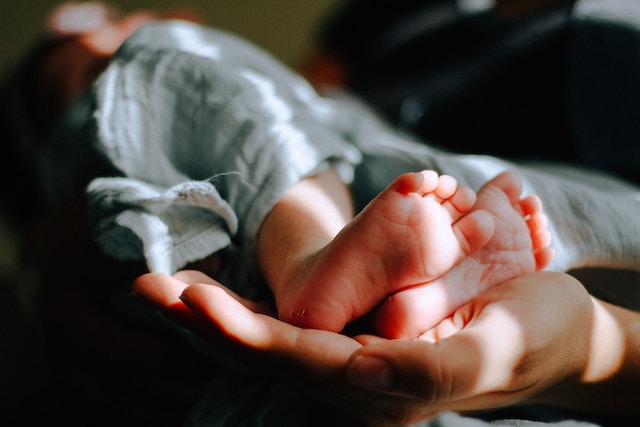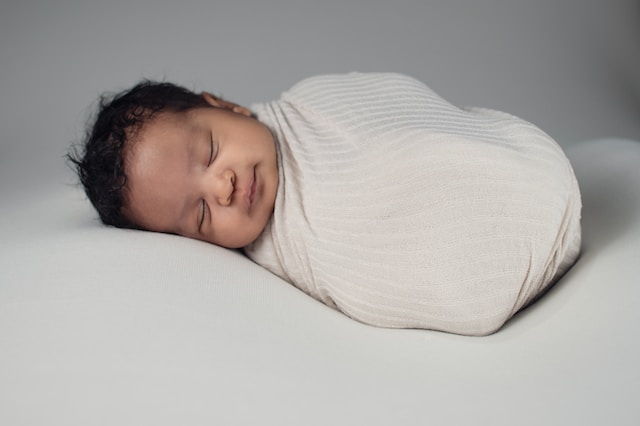The potential transformation of human reproduction is on the horizon as researchers explore the development of an “artificial womb”. In this article, we delve into the remarkable advancements that have been made in ectogenesis—the process of nurturing embryos outside the human body. These breakthroughs have the potential to reshape childbirth and reduce risks associated with traditional pregnancy.
Additionally, they could provide equal opportunities for individuals of all genders to experience parenthood, particularly for those in the LGBTQ+ community. However, as with any groundbreaking technology, there are important considerations and potential implications to be examined.

🔬Pioneering Developments in Ectogenesis
🔹 A Glimpse into the Future of Reproduction
In 2016, a research team at the University of Cambridge achieved a significant milestone by successfully culturing human embryos in vitro (artificial environment) up to the 13th day of fertilization. The following year, researchers at the Children’s Hospital of Philadelphia introduced the “Biobag,” an artificial womb capable of sustaining lamb fetuses equivalent in size and development to 22-week human fetuses until full-term.


The groundbreaking advancements continued in August 2022 when scientists at the Weizmann Institute of Science in Israel created the world’s first synthetic embryo using mouse stem cells. Simultaneously, researchers at the University of Cambridge successfully generated a synthetic embryo with a functioning brain and beating heart using stem cells.

🔹 Redefining Reproduction
The Potential of Ectogenesis Ectogenesis, or external gestation, has the potential to revolutionize the process of reproduction and mitigate risks associated with childbirth. It could provide a safer and more secure pathway for individuals who wish to conceive, eliminating health concerns, economic insecurities, and risks to bodily autonomy. By removing natural pregnancies from the equation, ectogenesis can offer an equal starting point for individuals of all genders, particularly those belonging to minority groups desiring parenthood.

🔹 The Prospects of a Prosperous and Equitable Society
If safe and effective ectogenesis becomes widely accessible, rather than privatized, it has the potential to foster a more prosperous and equitable society. However, it is crucial to address concerns that the development of ectogenesis may jeopardize the safety and legal rights to abortion for women and individuals with wombs, and potentially undermine global abortion policies.
🔬Ectogenesis and the Abortion Debate
🔹 Three Central Debates
Fetal Moral Status, Women’s Bodily Autonomy, and Fetal Viability Current philosophical literature and legislation surrounding abortion primarily revolve around three contentious arguments: the moral status of the fetus, women’s bodily autonomy, and fetal viability. Ectogenesis, by enabling the survival of fetuses at all stages of development, will inevitably influence these debates.
🔹 Anti-Abortion Stance
The Sanctity of Life Advocates against abortion tend to believe that a fetus is a person from the moment of conception, viewing the termination of an innocent life through abortion as morally wrong.
However, proponents of abortion rights emphasize bodily autonomy, often referencing the influential 1971 essay “A Defense of Abortion” by philosopher Judith Thomson. Thomson argues that even if a fetus is considered a person upon conception, a woman’s bodily autonomy—her right to decide what happens to her body—entails that removing the fetus from her body can be morally acceptable. The subsequent death of the fetus is an inevitable consequence of terminating pregnancy, rather than an intentional act of killing.
Read the book “A Defense of Abortion (Cambridge Studies in Philosophy and Public Policy)” to learn more.
🔹 Striking a Balance
Fetal Viability in Abortion Legislation To strike a balance between women’s bodily autonomy and the moral status of the fetus, many countries’ abortion laws utilize the concept of “fetal viability” (the ability of a fetus to survive outside the womb, including with the aid of medical devices) as a criterion for determining the “moral permissibility of abortion”.

According to the laws in many jurisdictions that permit abortion, when a fetus becomes viable, its right to life surpasses a woman’s right to bodily autonomy. For example, the abortion law in the United Kingdom only allows termination until the 24th week of fetal development, as it is considered the earliest stage at which a fetus can survive with medical support.
🔹 Ectogenesis
Expanding Reproductive Options Successful ectogenesis would allow fetuses to survive from very early stages, potentially even from conception itself. If ectogenesis (even in a partial capacity) becomes a possibility, unwanted pregnancies could be transferred to an artificial womb, ensuring termination without compromising a woman’s bodily autonomy. In this way, women could terminate pregnancies without resorting to traditional abortion methods, which might otherwise be perceived as intentional acts of killing.

🌱 The Moral and Social Implications of Artificial Womb
🔹 The Role of Fetal Viability
Traditionally, the central criterion in abortion ethics has been the “fetal viability,” which determines whether abortion should be permitted. However, as we enter the era of ectogenesis, where external development of embryos is possible, the moral and social acceptance of abortion may become even more contentious if viability remains the primary standard.
🔹 Potential Ban on Abortion
With the advent of ectogenesis, future legislation, particularly in conservative communities, states, and countries, might impose a comprehensive ban on abortion. While ectogenesis allows the termination of pregnancy without ending the life of the fetus, this alternative may still infringe upon a woman’s reproductive autonomy, especially from a feminist perspective.
Some women choose abortion not only to terminate pregnancy (preserving bodily autonomy) but also to avoid becoming a biological mother. Ectogenesis, however, could contradict their intentions by making them biological mothers against their will, thus potentially violating their reproductive autonomy.

🔹 Compelling Women to Transfer Embryos
Another possible scenario emerges when a woman desires an abortion, but her partner opposes it. With the availability of ectogenesis, it could lead to situations where women are coerced into transferring the fetus to an artificial womb against their wishes.
🌐 Addressing the New Choices: When Is Traditional Abortion Reasonable?
🔹 Defining Reasonable Choice
As ectogenesis technology further develops, activists and legislators will need to grapple with the question of when it is reasonable for women to opt for traditional abortion amidst new alternatives. In which circumstances should a woman’s desire not to become a biological mother outweigh the so-called rights of fetal survival?

🔹 Social Attitudes and Pressures
When exploring this issue, it becomes essential to consider why some women may reject becoming biological mothers even when they are relieved of the burden of raising a child (given that the child can be adopted after development in an artificial womb). Societal attitudes and pressures associated with biological parenthood can play a significant role in this decision.
Even if legal systems exempt biological mothers from legal obligations to their biological children, they may still feel a sense of duty or guilt for not embodying the self-sacrificial qualities typically associated with motherhood. Living with these emotional burdens can cause psychological harm to birth mothers and expose them to the risk of social stigma.

🔹 Balancing Desires and Rights
Certainly, a contentious question arises: does the desire to avoid potential social stigma or psychological distress supersede the so-called right to life of the fetus? This issue remains highly debatable and dependent on the extent of social pressure and the stage of fetal development. Nonetheless, if societal pressures are sufficient to inflict pain upon women who choose to use ectogenesis, then the desire of these women not to become mothers deserves respect, particularly during the early stages of fetal development.
💡 Legislating Ectogenesis: Ensuring Reproductive Autonomy
🔹 Preserving Bodily Autonomy
Legislation surrounding ectogenesis must take into account the principle of bodily autonomy, ensuring that women have the right to decide which procedures are performed on their bodies. Although the specific process of transferring a fetus to an artificial womb remains unclear, it will likely be invasive, potentially akin to cesarean section, especially in later stages of pregnancy.
Women should have the right to refuse external interventions based on bodily autonomy. Otherwise, as Canadian philosopher Christine Overall points out, forcing a transfer procedure would be tantamount to organ theft, which is highly unethical.

🔹 Complex Ethical Challenges
Ectogenesis further complicates the ethics of abortion, as it not only coerces women into accepting external interventions but also violates their reproductive autonomy and bodily freedom. In a world where ectogenesis technology exists, allowing early-stage abortions may serve as a viable compromise to minimize complications and safeguard women’s rights. However, to ensure reproductive rights, abortion must remain a viable choice even after the advent of ectogenesis.
🔹 Repositioning Abortion Rights
Future legislation must guarantee that ectogenesis remains a choice rather than a new form of compulsion. The right to abortion needs to be repositioned legally around the values of “reproductive autonomy” and the “right not to become a biological parent against one’s will” rather than solely focusing on fetal viability. As this legal debate gains attention from politicians, lawmakers, community leaders, and the general public, the level of respect for women’s reproductive choices and rights will be more significant than ever before.


